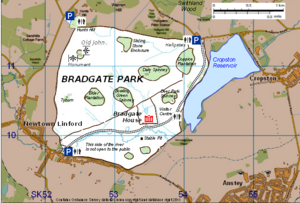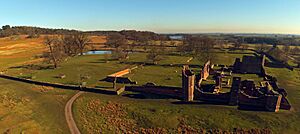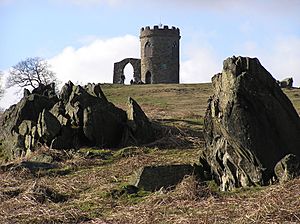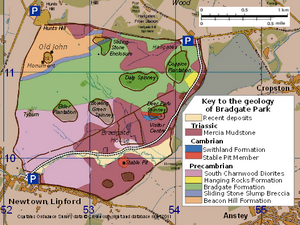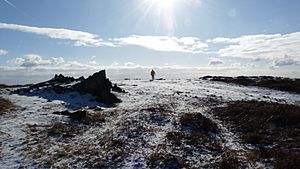Bradgate Park facts for kids
Quick facts for kids Bradgate Park |
|
|---|---|
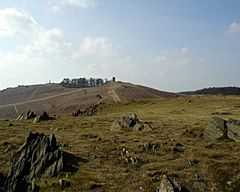
Rocks, Old John and the War Memorial
|
|
| Lua error in Module:Location_map at line 420: attempt to index field 'wikibase' (a nil value). | |
| Type | Medieval Deer Park |
| Location | Leicestershire, UK |
| Nearest city | Leicester |
| OS grid | SK529107 |
| Area | 850 acres (340 ha) |
| Elevation | 75-80m to 212m (c.250 - 700ft) |
| Created | 1500 (Public Park from 1928) |
| Operated by | Bradgate Park and Swithland Wood Charity (Registered Charity no. 521476, (popularly known as the Bradgate Park Trust) |
| Visitors | 900,000 |
| Open | all year, 7.45 am to dusk |
Bradgate Park is a large public park located in Charnwood Forest, Leicestershire, England. It's found northwest of the city of Leicester. This amazing park covers about 850 acres (344 hectares) of land.
The park is surrounded by several villages, including Newtown Linford, Anstey, Cropston, Woodhouse Eaves, and Swithland. The River Lin flows right through the park. It eventually empties into Cropston Reservoir, which was built on part of the park's land. To the northeast, you'll find Swithland Wood.
Bradgate Park has two famous landmarks: Old John and a war memorial. Both sit high up on a hill, about 210 meters (689 feet) above sea level. The park is also a special place for nature and geology. It's part of a "Site of Special Scientific Interest" because of its important plants, animals, and ancient rocks.
After a fire in April 2017, the park's owners, the Bradgate Trust, asked all visitors to be careful to prevent fires. Sadly, another fire in June destroyed one of the park's very old oak trees.
Contents
Bradgate Park's Long History
The area we now know as Bradgate Park has a very long history. It was once part of many parks around Charnwood Forest. Since medieval times, it belonged to the Manor of Groby.
In the 11th century, after William the Conqueror took over England, the land was given to Hugh de Grandmesnil. The name "Bradgate" might come from old Norse or Anglo-Saxon words, meaning "broad road" or "broad gate."
The first time Bradgate Park was mentioned was in 1241. Back then, it was a hunting park, but it was smaller than it is today. Over time, it was owned by different powerful families. In 1445, it passed to the Grey family, who kept it for the next 500 years!
In the 19th century, the Grey family started opening the park to the public a few days a week. Then, in 1928, a kind businessman named Charles Bennion bought the park. He gave it to the people of Leicestershire to be kept in its natural state for everyone to enjoy.
Medieval Deer Park
Originally, the park was fenced off with a bank and a ditch, topped with tall oak poles. A "parker" (a person who looked after the park) lived in a special house and made sure there were plenty of deer for the lord of Groby Manor to hunt.
The park was made much bigger in the late 1400s. It took over land that used to be farms for the villages of Newtown Linford and the lost village of Bradgate. The stone walls you see today were built in the 1600s and early 1700s.
Bradgate Park still has herds of red deer and fallow deer. These deer have probably lived here continuously since medieval times!
Bradgate House: A Royal Connection
The Grey family built Bradgate House. It was likely finished around 1520. However, older parts of the house have been found, suggesting it might have been built even earlier.
Lady Jane Grey A very famous person was born at Bradgate House: Lady Jane Grey. She was born on October 12, 1537. Her mother, Frances, was the daughter of Mary Tudor, Queen of France, who was King Henry VIII's younger sister.
Lady Jane Grey became Queen of England for just nine days in 1553! This was a very short and sad time in her life.
Old John: A Mysterious Tower
One of the most famous landmarks in the park is a tower called 'Old John'. It's a folly, which means it's a building built just for decoration or a special purpose, not for living in. The Grey family built it in 1784.
Local stories say Old John is a memorial to an estate worker named John. He supposedly died in a bonfire accident during a birthday party. People say the tower's stonework was changed to look like a handle, because John loved ale. However, maps from 1745 already show the hill named 'Old John', so the story might not be entirely true!
In the 1800s, the tower was used as a viewing point for horse races that took place in the park.
Cropston Reservoir
Cropston Reservoir was built in the park in 1871. This meant that the Head Keeper's house and a large part of the parkland were covered by water. It was built to provide water for Leicester, especially after serious illnesses spread in the city.
The water level was raised in 1887 to hold more water. The original steam engines that pumped the water worked until 1956. Smaller pools were also built along the River Lin to help clean the water before it reached the reservoir.
Bradgate Park Becomes Public
For a long time, only limited public access was allowed to Bradgate Park. But in 1928, Charles Bennion bought the park and gave it to the people of Leicestershire forever. Plaques in the park remember this generous gift.
Later, Bennion's son gave more land to the park. In 1936, the City Council also bought more land next to the park.
Nearby, Swithland Wood was also saved for the public. In 1921, a timber merchant bought it and started cutting down trees. People were worried about losing this ancient woodland. So, in 1925, the Rotary Club of Leicester bought the wood to protect it and allow public access.
The Rotary Club then worked to make Swithland Wood ready for visitors. They opened it to the public in August 1925. In 1931, Swithland Wood joined with Bradgate Park under the same management.
Today, Bradgate Park is looked after by the Bradgate Park and Swithland Wood Charitable Trust. This trust makes sure the park stays a beautiful place for everyone to enjoy.
Amazing Geology
Bradgate Park is a fantastic place to see very old rocks! Some of the rocks here are among the oldest in England, dating back to the Precambrian period. This was about 560 million years ago!
These rocks were formed in many different ways. Some came from volcanoes rising out of the ocean. Others formed deep underground from hot magma. There were also times when the area was a tropical desert or covered by huge Ice sheets.
You can see these rocks all over the park, especially along the River Lin valley and on the hill where Old John stands. Bradgate Park is one of the few places in Britain where you can see these ancient "basement rocks" at the surface.
Precambrian Rocks
The oldest rocks in Bradgate Park are part of the "Charnian Supergroup." These rocks formed about 560 million years ago. The rocks near Old John and the war memorial are from the Beacon Hill Formation. They likely formed deep underwater from volcanic ash.
Further down the hillside, you'll find the Bradgate Formation rocks. These include the "Sliding Stone Slump Breccia" rocks. These rocks are made of layers of mudstone and sandstone, mostly from volcanoes. They are twisted and folded, probably from things like underwater landslides or earthquakes when they were still soft.
The youngest Precambrian rocks are the South Charnwood Diorites. People often call these "granite." These rocks formed when hot magma pushed into the older rocks deep underground. They cooled very slowly, creating large crystals. You can see these big, blocky rocks along the Lin valley and near Bradgate House.
Cambrian Rocks
Some rocks in the park, like those at Hanging Rocks, might be from the very late Precambrian or early Cambrian period. These rocks have rounded volcanic pebbles, suggesting they might have been smoothed on a volcanic shoreline before being washed into deeper water.
The Swithland Slate, which was used for roofs and gravestones, is an early Cambrian rock. You can see similar rocks in a medieval quarry near Bradgate House.
Triassic Rocks
Much later, about 350 million years after the ancient rocks formed, they were exposed to the air. During the Triassic period, the area was a desert. Wind-blown dust and sand settled, forming red clay. This clay was used to make the bricks for Bradgate House! You can still see this clay where it was dug out, across the stream from Bradgate House.
Ice Age Deposits
More recently, during the last ice age (about 10,000 years ago), Bradgate Park was covered by thick ice. As the ice melted, it left behind a mix of clay, sand, pebbles, and large boulders. These materials traveled long distances within the ice, so some rocks in the park's walls might have come from far away!
Ancient Fossils
Bradgate Park is incredibly special because it has some of the only known Precambrian fossils in Western Europe! Before 1957, people thought that complex life only began in the Cambrian Period. But in 1957, a geologist named Roger Mason found fossils near Woodhouse Eaves, which were named Charnia masoni after him.
These discoveries changed what we know about when life began on Earth. The fossils are usually flat impressions of fronds and disks. They are now part of the Ediacaran biota, which are ancient life forms that don't fit into modern animal or plant groups.
At Bradgate Park, you can find fossils like Bradgatia linfordensis, Charniodiscus concentricus, and Charnia masoni. To protect these rare fossils, their exact locations are kept secret. If you want to study them, you need to ask permission from the Bradgate Park Trust. It's very important not to chip, hammer, or remove any rocks from the park.
Plants and Animals
The park's landscape is mostly rocky moorland with rough grass and bracken plants. There are also several small woodlands, called spinneys, with pine and other trees. These are fenced off to protect the wildlife.
Bradgate Park is home to large herds of red deer and fallow deer. You'll also see many types of birds. The reservoir attracts many kinds of wildfowl (water birds), and the river and spinneys provide safe places for other birds to nest. You might spot rooks, yellowhammers, reed buntings, skylarks, and meadow pipits in the open areas.
Interestingly, Deadly nightshade grows within the ruins of Bradgate House. It was planted there during World War II by a pharmacy school for medicinal purposes.
Dogs in the Park
As of 2015, there were about 450 deer in the park. Sometimes, dogs chasing deer has been a concern. So, notices at the park entrances now ask dog owners to keep their dogs on a lead in certain areas near the main path. Dogs can be off-lead in about 75% of the park, as long as they are well-controlled and don't bother the deer.
Visitor Information
In July 2016, a new visitor centre opened in the Deer Barn buildings, near Bradgate House. It has sections about the park's geology, showing how the rocks formed from volcanoes and ice ages. It also talks about the ancient fossils found there. The archaeology section shows discoveries from 2014, including signs of human activity from 14,500 years ago!
There's also a cafe and gift shop at the Newtown Linford entrance.
How to Get There
You can park your car at the Hallgates entrance, Newtown Linford, and Hunts Hill (near Old John). The park is open from dawn until dusk all year round. Public footpaths also run through the area, so you can always access the park.
You can also get to the park by bus. Bus route 120 stops near the Newtown Linford entrance. Bus route 154 travels between Leicester and Loughborough, stopping near the Hallgates entrance. There are also two footpaths from the village of Anstey, which you can reach by taking the 74 bus from Leicester.
The park is also easy to reach by bike from Leicester city centre.
Images for kids


